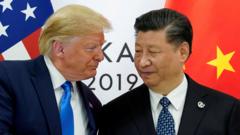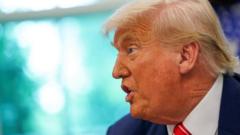As NATO leaders prepare for a crucial summit, Dutch Prime Minister Mark Rutte seeks to bolster defense contributions while appeasing U.S. President Trump with an ambitious proposal of increasing spending to 5% of GDP, significantly surpassing the current guidelines.**
NATO's Defense Spending Strategy: Aiming for a 5% GDP Target Amid Political Pressures**

NATO's Defense Spending Strategy: Aiming for a 5% GDP Target Amid Political Pressures**
The NATO summit readies for a potential paradigm shift in defense spending, driven by U.S. pressures and European compliance.**
NATO Secretary General Mark Rutte is rallying support for an ambitious defense spending target as the alliance approaches its upcoming summit, signaling a shift intended to reassure U.S. President Donald Trump. Rutte, wary of critiques from the Trump administration regarding European nations’ commitments, has proposed a substantial increase in defense budgets among member states to 5% of GDP. This proposal sharply contrasts with the present target of 2%, a benchmark many NATO countries have struggled to meet.
In a press conference in Brussels, Rutte articulated the urgency of responding to U.S. demands for higher defense spending, emphasizing the need to avoid past confrontations like those witnessed in 2016 when Trump publicly criticized European allies for perceived fiscal shortfalls. The proposed increase is poised to be a significant challenge for several nations, who might question whether this move is primarily a measure of deterrence against Russia or an effort to placate the U.S. leadership.
The new spending structure would establish a commitment of 3.5% for core defense initiatives, with the remaining 1.5% allocated for "defense-related expenditures," a term that provides leeway for member states to interpret their spending obligations broadly. Rutte noted that this category could encompass costs concerning defense infrastructure and industrial development, giving nations flexibility in meeting the revised target.
While the U.S., currently spending approximately 3.4% of its GDP on defense, is likely to embrace this new commitment, the real challenge lies in translating these commitments into actual expenditures over time. The nations involved will not face strict penalties for noncompliance, making long-term adherence a pressing concern. Rutte seeks to implement a system requiring member states to present annual plans that demonstrate year-on-year increases, thereby avoiding a sudden spike in spending in the final years of the target period.
Next week, Rutte is slated to meet with UK Prime Minister Sir Keir Starmer, whose defense spending plans currently project a 2.5% contribution by 2027, with aspirations for an increase to 3% within the following parliamentary term. During a recent NATO defense ministers' meeting, U.S. Defense Secretary Pete Hegseth expressed optimism that various countries, including France, Germany, and several Eastern European nations, would align with the proposed 5% defense spending commitment, extending a belief that the UK’s position would converge towards this goal as well.



















